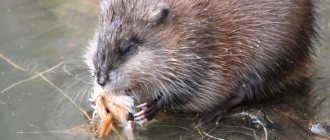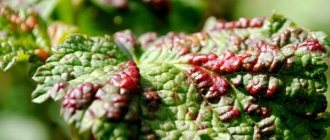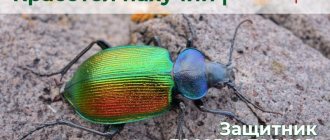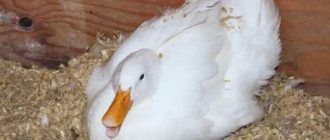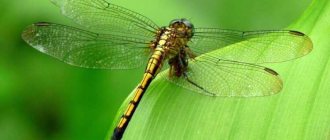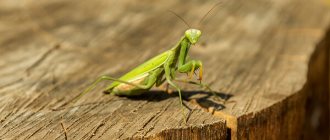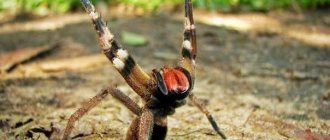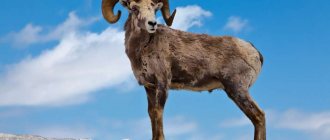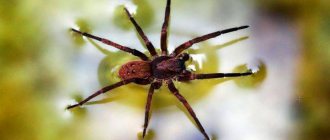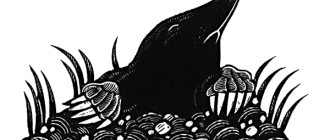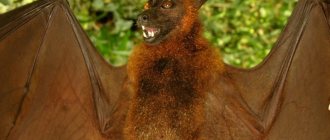Dragonflies are the oldest flying insects. Large individuals with a movable head and large eyes are active predators. The Emperor Watchman is a prominent representative of the suborder of heteroptera dragonflies. Its two pairs of wings are located perpendicular to the body; in flight they do not move evenly. Insects live near bodies of water where their offspring are born. Due to pollution of water bodies, the number of dragonflies is rapidly declining; the species is listed in the Red Book of Russia.
Appearance of an insect
The Emperor Watcher (Anaximperator), Overlord Watcher or Blue Emperor is a large dragonfly from the rocker family. She belongs to the family of watchmen. Its body size is 65-75 mm, wingspan is 90-110 mm. The insect's head and chest are green. There are two pairs of wings, they are transparent, the wing plate is gray-white with black veining. The Emperor Watcher Dragonfly alternates between the front and rear pairs of wings in flight. This feature provides freedom of maneuver. The flight speed of insects reaches 40-50 km/h.
The abdomen is long and thin, on the last segment there are peculiar spines used during mating. The main color is blue with dark spots. The abdomen accounts for 90% of the body length. It consists of 10 segments formed by chitinous scutes. Between them there are stretchable membranes that allow the dragonfly to bend its abdomen.
Most of the head is occupied by large compound eyes of blue-green color. In the rocker family, they touch over a short distance. The antennae are inconspicuous, thin and short. The oral apparatus is of a gnawing type with well-developed powerful jaws. The larvae are stocky, with a rounded head and large eyes. They grow up to 45-55 mm. The brown body is covered with a chitinous shell. The larvae have gills for breathing underwater.
Sexual dimorphism
The female differs from the male in the golden color of her wings. Their abdomen is blue or green and covered with reddish-brown spots. The wing plates of males are not colored. The abdomen is blue, with a wide, broken black stripe running longitudinally across the top.
INTERESTING FACTS ABOUT DRAGONFLY
Naiad is the name given to the larvae of dragonflies and other insects whose life occurs in two environments: aquatic for the larvae and air for the adult insects. The naiad becomes an adult insect after several molts, bypassing the pupal stage. — The larvae of heteroptera dragonflies, which include the watchman, at the initial stage of development have two hearts: one in the head, and the other in the back of the body. They have five eyes, 18 ears, an 8-chambered heart, and green blood.
Lifestyle
Representatives of the order of dragonflies lead an amphibiotic lifestyle - their eggs and larvae develop in water, and adults live on land. Dragonflies are aerial predators without food specialization. The emperor's watchman has an individual way of hunting. In flight, it uses legs with long spines to form a basket-trap with which it captures prey. Predators destroy harmful insects - mosquitoes, flies and horseflies, this is their main diet. Dragonflies also catch butterflies and caddis flies. They are active during the day and prefer warm, sunny weather.
Information. Dragonflies are excellent flyers; they move tens and hundreds of kilometers in search of a new home.
Dragonflies are insects with incomplete metamorphosis; they go through three stages of development: egg, nymph and adult. The insects fly from mid-June to October. They lead a solitary lifestyle and only intersect with individuals of the opposite sex during mating. Representatives of the rocker family are ardent individualists. Males divide the coastal area of the reservoir and the nearby meadow into sections at a distance of up to 100 m. Each aggressively guards its own hunting grounds. Only females are allowed to cross the border. The lifespan of the imago is 4 weeks. Adults can fly away in search of prey several kilometers from the reservoir. Watchmen belong to the upper tier of hunters; they fly at an altitude of 2-10 m. Small prey is eaten on the fly, while large ones are considered a resting place.
Interesting fact. When there is a large amount of prey, dragonflies gather in hunting flocks of up to 20 individuals.
The larva is a predator in the pond
Offspring live in stagnant water, preferably in shallow, overgrown ponds. The larva is no less active predator than the adult dragonfly. She swims along the bottom of the reservoir and attacks any prey smaller than herself. The food is small crustaceans - daphnia, amphipods. The adult larva is capable of attacking fish fry and tadpoles.
Attention. An adult dragonfly larva will grow up to 60 mm and is harmful to fisheries by damaging the fry.
The larva has weak limbs, so it prefers to sit on stones or plants most of the time. The hunting method is a rapid attack on the victim from an ambush. In the process of swimming, the larva uses the principle of jet propulsion.
NEAR THE WATER
The entire life of watchmen is connected with water bodies of forest landscapes - both open and closed. These dragonflies make their many-kilometer flights precisely in order to colonize new bodies of water. In mid-June, after the last molt, young dragonflies emerge. They are colored the same: the abdomen is green or bluish with brown markings, and the wings are dark. Over time, the wings lighten and become gray-white, and the abdomen of the males acquires its legendary blue-blue hue. The females remain greenish. Males and females behave differently: males remain near the water, and females prefer to feed on the edges of forests, in forest belts, and bushes. High speed (and it can reach 60 km/h), sharp vision (the eye of a dragonfly consists of 28 thousand facets, which is seven times more than that of a fly), quick reaction and an iron grip on the “basket” that their legs form, clasping prey, allow watchmen to catch even large and dangerous insects. And yet their main food is mosquitoes. During the mating period, each male chooses an individual area for himself and patrols it, not allowing strangers there: there he mates with his “chosen one” on the fly. Or rather, on the contrary, the female flying past catches up with the male and makes her her chosen one, and after three or four days she begins laying eggs. She lays eggs one at a time, on aquatic plants - pondweed and others. Therefore, it is important that the reservoir is sufficiently overgrown, stagnant or low-flowing. Typically, a female mates several times during her life.
Features of reproduction
Male dragonflies are not known for their gentle courtship. They grab the female's head with special devices on the abdomen and hold it until the spermatophore is in the genital opening. The ovipositor of females is formed by four stylets, and there is a genital valve. After fertilization, they lay elongated beige eggs on the underwater parts of the plants. There are 250-500 eggs in a clutch. The incubation period is about 4 weeks. As the temperature decreases, it lengthens. Eggs are the most vulnerable period of development. Many die from exposure to weather conditions and are eaten by predators.
Interesting fact. Males patrol the territory of the reservoir to prevent other dragonflies from laying eggs, creating competition for their offspring.
The larva develops within 1-2 years, the period of its maturation depends on the temperature and illumination of the reservoir. She goes through 7-11 moults, in the southern regions of Russia the last one occurs in May, in areas located further north, in mid-June. The adult larva leaves the pond and climbs onto plants, where it transforms into an adult. The insect dries until the skin bursts and an adult dragonfly emerges. It takes up to 6 hours for her to spread her wings and harden her chitinous cover. All this time the watchman is hiding in the thickets of coastal plants.
Stag beetle
The insect belongs to the family of stag beetles, being one of the largest beetles living in European territory. Males are usually larger than females and in some cases reach a length of up to 85 mm.
Among the members of the animal's body, the red-brown horns located on the head, where there are also eyes and antennae, are especially distinguished. It should be noted that such decoration is exclusively the property of males. The underparts of such creatures are usually black, and three pairs of legs extend from the chest.
The stag beetle is capable of flight, but males are much more successful at flying than females. It is interesting that the mating of such living creatures, which occurs in trees, lasts up to three hours.
And the cream-colored larvae, which hatch as a result of this from eggs laid further, measure up to 14 cm by the end of their development.
The stag beetle is found in Europe, mainly in areas with warm climates, and their habitat extends all the way to northern Africa. Insects inhabit deciduous forests, parks, gardens and oak groves, also spreading in mountainous areas and in river openings.
The stag beetle is one of the largest beetles in Russia
Giant beetles prefer to live on deciduous trees, of which oaks are the most popular. But linden, beech, ash, pine and poplar are also quite suitable for their life.
Despite the terrifying horns, such living creatures are quite harmless and feed mainly on plant sap. It is curious that these giant insects usually live no more than a month.
The decline in the number of stag beetles is due to changes in the habitat, human activity, sanitary cleaning and encroachments on their tranquility by collectors.
Reasons for the reduction of the species
In North Africa and partly in Western Europe, this species of dragonfly is not in danger of population decline. In the Russian Federation, the situation is more complicated; a normal number of dragonflies was noted only in the Transcaucasus, Stavropol and Krasnodar Territories. In the northern regions, their numbers drop sharply.
Interesting fact. The image of the watchman-emperor is applied to the coin of the Central Bank of Russia with a face value of 2 rubles.
The watchman-emperor reacts sharply to the ingress of chemical pollutants into water bodies. The insect lives only in clean lakes and ponds. In areas with a large number of residents and industrial facilities, water pollution occurs regularly. This was the main reason for the sharp decline in the insect population. The emperor dragonfly is listed in the Red Book of Russia as a declining species.
Habitat
This species has inhabited almost all natural areas of the Earth. Their habitat extends from Scandinavia to southern Africa. But, as a rule, the Emperor Watcher is found quite locally. In Russia, this species has inhabited the southern side of the European part.
As places to live, these dragonflies choose areas near bodies of water with standing water, located near forests.
water chestnut
Water chestnut is a herbaceous annual that is found in Far Eastern rivers. This relict species develops exclusively in warm water. In low-flowing reservoirs it forms dense thickets. The glossy leaves are shaped like birch leaves. White flowers appear in midsummer. Ripe fruits look like the head of a devil. For a long time, water chestnut seeds were collected en masse for culinary and medicinal purposes. Today the plant suffers due to pollution of water bodies and long dry periods. To restore numbers, control over the state of the population is necessary.
Master of the Pack
This large flying creature, similar to a stingray, is used by the Swarm for aerial siege. The owners of the pack, participating only in large battles, are capable of spitting out symbionts that serve as living weapons. Once outside the host's body, they pounce on the target and either devour it or die in the attempt. This method of attack makes the owner of the pack extremely dangerous for enemy buildings. However, for all their offensive power, the swarm masters are not very durable and become easy prey for most air forces.
Legacy of the Void
Heart of the Swarm
Wings of Liberty Data
Watcher Emperor
The range of the Emperor's Watcher is unusually wide and covers lands from the Scandinavian Peninsula to South Africa, and in Europe it stretches from Portugal through Germany to the north. The dragonfly can be found in the southern part of Sweden up to the city of Uppsala. The species is widespread in Great Britain, especially in southern England and southern Wales.
In the east of Eurasia, the range reaches the Arabian Peninsula and Central Asia. In Russia, the insect lives within the southern half of the European part, its habitat is mosaic, with increasing fragmentation in the direction from southwest to northeast. In general, the dragonfly is distributed locally. The insect is found in reservoirs located in open and forest landscapes.
The main habitats are littoral zones of large lakes, sometimes low-flowing reservoirs.
What does it look like
The Emperor's Watcher is one of the large European dragonfly species. Its body reaches 65–78 mm in length, and its wingspan is 90–110 mm. Insect is heteroptera. The wings are transparent, 50 mm long, the gray-white contrasting plate has black veining. The chest is green with wide black stripes at the seams.
Legs with long spines, brown, turning yellowish at the base. In flight, they fold into a catching basket for insects. The eyes are large, faceted, blue-green in color. The abdomen is elongated, its last segment bears a kind of forceps, which are necessary for males for mating.
The larvae are brown in color with a stocky body and a rounded head on which are located very large eyes. They reach 45–56 mm in length.
Lifestyle and biology
The flight of insects begins in May and continues until the end of August. Adults are active predators. Their diet includes very large moths, small dragonflies, mosquitoes and flies. The male has a territory that he constantly patrols. He allows only females into his possessions. Mating and egg laying also take place here.
During copulation, the male grabs the female's head with claw-like appendages located at the posterior end of the abdomen and drags her until she brings her genital opening to the spermatophore. The female lays eggs on aquatic plants, such as reed stems, or on objects floating in the water - pieces of bark, twigs.
The male does not accompany her.
The larvae of the emperor watcher (phytophylls) develop in stagnant and low-flowing water bodies. They are ambush predators and usually move slowly among aquatic plants.
During this time, about 12 molts occur.
The emergence of an adult from the larva begins at the end of May and continues until mid-June. The emerging adults scatter quite widely: in search of food, they move 3–4 km from the nearest body of water. Females prefer forest edges and bushes, males often concentrate near water.
Listed in the Red Book
At the moment, about 55% of the Emperor's Watcher's habitat is not suitable for normal existence.
In some countries of Western Europe and North Africa, insects can still be observed in large numbers.
In Russia, their numbers are steadily declining, and in its European part, in some densely populated areas, dragonflies have disappeared completely. Pollution of wetlands is usually to blame.
Natural limiting factors are temperature conditions and competition with dragonflies of the genus Aeschna, which are especially numerous on the northern border of the species.
The Imperial Watchman is listed in the Red Books of Russia and Belarus. In addition, it is protected in conjunction with other insects on the territory of several Russian nature reserves.
Peony thin-leaved
A perennial plant growing in the European part of the country.
Thin-leaved peony can be found in the steppe zone, on rocky mountain slopes, forest edges and clearings. The height of the plant can reach half a meter. Peony leaves are thin and divided into feathers. Flowering occurs at the beginning of May. The color of the flowers varies from purple to blood red. The diameter of one flower is up to 8 cm. Terry specimens are rare. The plant is winter-hardy and drought-resistant, but does not bloom well in shaded areas. Due to the reduction in the area of the steppes, the number of peonies has sharply decreased. Today it can only be found in lands inaccessible for plowing. Another negative factor is grazing by livestock, which tramples the aboveground part of the plant. Also, thin-leaved peony suffers from massive collection and digging of rhizomes. Numerous populations have survived only in the territories of nature reserves.
Limiting factors and threats
Eurytopic, but not numerous species. During periods of climate mitigation, it actively spreads and prefers to populate large artificial reservoirs, including moderately polluted ones (up to class 4 cleanliness), withstanding competition with local species of dragonflies. It may disappear, first of all, as a result of prolonged winter frosts and an insufficient amount of effective temperatures, which are not typical for the steppe zone, where the optimum range of the species begins. Of the anthropogenic impacts, the complete destruction of high coastal vegetation necessary for the breeding of adults, as well as severe pollution of water bodies, are especially unfavorable for the species.
Ground beetle Avinova
This beetle is a member of the ground beetle family, found in the mountainous regions of Sakhalin Island. It has a length of 20 or more centimeters. The back has a copper-red color, the elytra glow with a greenish-bronze hue.
The beetles are black below, and their sides have a metallic tint. These living creatures form a few clusters in mixed, spruce and fir forests, rich in thickets of tall grass.
This type of insect is poorly studied, and very little data can be found on these creatures. They are known to be predators, consuming various types of small invertebrates and molluscs.
The peak of insect reproduction occurs in early July, and in winter they fall into suspended animation, most often finding shelter during the frost period in rotten fir stumps.
The number of beetles is sharply declining, mainly due to the fact that they are becoming the object of close attention of collectors, and also the population size is negatively affected by human economic activity.
Lifespan
We have looked at some of the structural features of dragonflies, but it is also important to clarify that they can live up to ten years. These are real long-livers in the world of insects. Let's talk a little more about this
Let's talk about this a little more.
In total, there are more than 6.5 thousand species of these unusual, graceful and beautiful creatures on our planet. On the territory of Russia you can find a small number of species, about 150. So, the lifespan of dragonflies directly depends on the species, the minimum is two months, and the longest-livers can last about ten years. This period includes the full development cycle of insects, and the development of the larvae in some species can take more than one year.
The external structure of a dragonfly directly depends on the species. There are only three suborders of these insects:
How are they different? The first species has two pairs of wings, they are narrow and almost identical in shape. If the dragonfly is at rest, then both the front and rear wings are raised up and connected to each other. In the second case, the wings have a different shape and, at rest, are spread out to the sides. The third suborder includes a single genus; these insects are common in Japan and India. The peculiarity of the latter is also that they combine the characteristics of the first and second suborders.
The most common representatives of homoptera dragonflies:
- Beauties.
- Arrow.
- Lute Dryad.
- Megaloprepus caerulatus.
It is also very important to know that the last of these are the largest dragonflies in the world. Their body length reaches ten centimeters, and their wingspan reaches nineteen. Prominent representatives of the heteroptera suborder:
Prominent representatives of the heteroptera suborder:
- Watcher-emperor.
- Cordulegaster annulated.
- The headstock is metal.
- The grandfather is ordinary.
- Common dragonfly.
